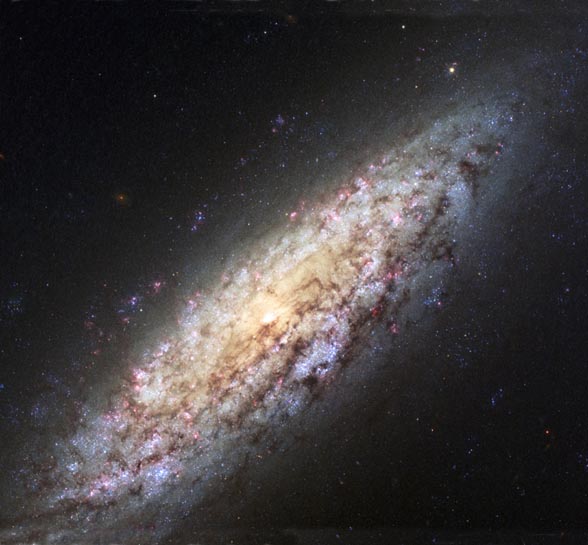
Spiral Galaxy with Active Star Formation
RA: 17h 49m 26.43s Dec: 70° 08' 39.73"
Draco
18 million light-years (5.5 megaparsecs)
April 21, 2003 and August 21, 2013
2.68 x 2.24 arcminutes
North is 11.8° left of vertical
NASA, ESA, D. Calzetti (U of Massachusetts, Amherst), H. Ford (JHU), and the Hubble Heritage (STScI/AURA)-ESA/Hubble Collaboration
June 8, 2015
2010 Image: G1032wea
ABOUT THIS IMAGE:
This magnificent spiral galaxy is at the edge of what astronomers call the Local Void. The Local Void is a huge volume of space that is at least 150 million light-years across that doesn't seen to contain anything much. There are no obvious galaxies. This void is simply part of the structure of the universe where matter grows clumpy over time so that galaxies form clusters and chains, which are separated by regions mostly devoid of galaxies. This results in sort of a "soap bubble" structure on large scales.
Most galaxies are clumped together in groups or clusters. A neighboring galaxy is never far away. But this galaxy, known as NGC 6503, has found itself in a lonely position, at the edge of a strangely empty patch of space called the Local Void.
The Local Void is a huge stretch of space that is at least 150 million light-years across. It seems completely empty of stars or galaxies. This void is simply part of the structure of the universe where matter grows clumpy over time so that galaxies form clusters and chains, which are separated by regions mostly devoid of galaxies. This results in sort of a "soap bubble" structure on large scales. The galaxy's odd location on the edge of this never-land led stargazer Stephen James O'Meara to dub it the "Lost-In-Space galaxy" in his 2007 book, Hidden Treasures.
Astronomers discovered that the emptiness of this region has quite an effect on the space around us - the Milky Way is being strongly pulled away from it by the gentle but relentless tug of other nearby galaxies.
NGC 6503 is 18 million light-years away from us in the northern circumpolar constellation of Draco. NGC 6503 spans some 30,000 light-years, about a third of the size of the Milky Way. It has an almost non-existent central bulge surrounded by a massive halo of gas.
The galaxy's central region is a good example of something known as a "low ionization nuclear emission region", or LINER. These are less luminous than some of the brightest galaxies. Emission from NGC 6503's heart is believed to be the result of a starved black hole that is only just being kept active, receiving a very small amount of infalling gas to keep its large appetite at bay.
A previous image of NGC 6503 was released as a Hubble Picture of the Week back in 2010, taken by Hubble's Advanced Camera for Surveys. However, this new image, taken using Hubble's Wide Field Camera 3 (WFC3), shows NGC 6503 in striking detail and with a richer set of colors. Bright red patches of gas can be seen scattered through its swirling spiral arms, mixed with bright blue regions that contain newly forming stars. Dark brown dust lanes snake across the galaxy's bright arms and center, giving it a mottled appearance.
Installed in 2009 during the final Hubble servicing mission, the WFC3 covers a wide range of the spectrum, from the ultraviolet all the way through to the near-infrared. Compared with its predecessor, the Wide Field and Planetary Camera 2 (WFPC2), it offers improved resolution and a wider field of view, and has led to a large number of stunning Hubble images since its installation.
The
Hubble Advanced Camera for Surveys data for NGC 6503 were taken in April
2003, and the Wide Field Camera 3 data were taken in August 2013.
Color:
This image is a composite of separate exposures acquired by the ACS/WFC
and WFC3/UVIS instruments. Several filters were used to sample various
wavelengths. The color results from assigning different hues (colors)
to each monochromatic (grayscale) image associated with an individual
filter. In this case, the assigned colors are:
F275W (UV) pink F336W
(U) purple F438W
(B) blue
F555W (V) green
F814W (I) red
F658N (H-alpha+[N II]) red